International Finance: Evaluating Investment and Hedging Strategies
VerifiedAdded on 2020/05/16
|10
|2335
|112
Report
AI Summary
This report delves into various aspects of international finance, focusing on investment decisions, hedging strategies, and currency risk management. It begins by evaluating investment alternatives, specifically comparing investments in Chinese interest rates versus US coco bonds, considering currency exposure and potential returns. The report then explores the structure and benefits of currency swap transactions for an Australian company with a Chinese subsidiary. It analyzes the implications of interest rate parity and examines whether hedging with forward rates or money market hedges would be beneficial under different scenarios. Furthermore, it assesses the impact of real interest rates and inflation on the appreciation or depreciation of the Chinese Yuan. The report also discusses how businesses are affected by changes in Chinese interest rates and whether high interest rates in China will entice Australian investors. Finally, it addresses concerns regarding currency exposure and suggests instruments like future contracts, option contracts, and currency swaps to hedge future cash remittances to Australia, providing a comprehensive overview of international finance concepts and practical applications.
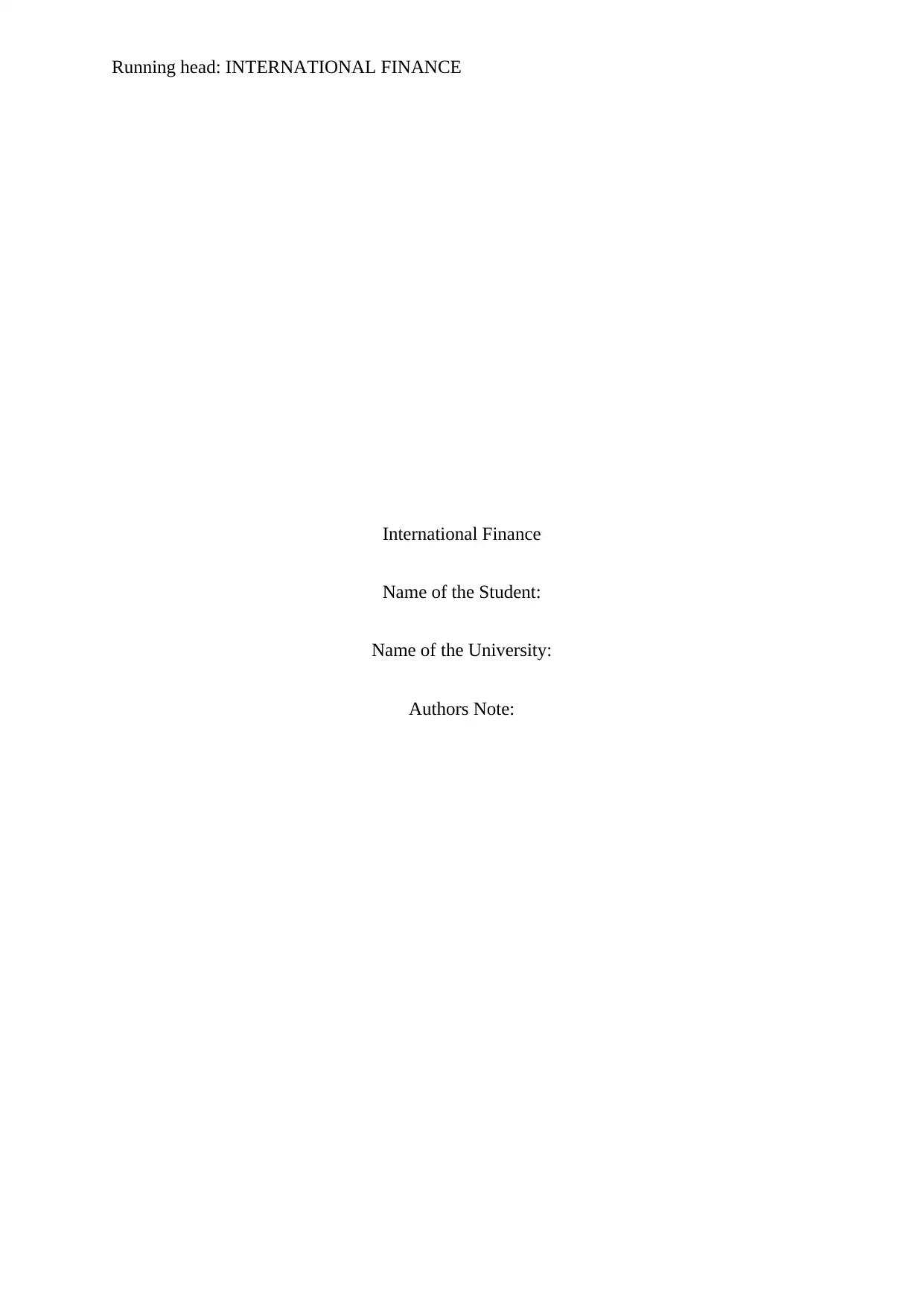
Running head: INTERNATIONAL FINANCE
International Finance
Name of the Student:
Name of the University:
Authors Note:
International Finance
Name of the Student:
Name of the University:
Authors Note:
Paraphrase This Document
Need a fresh take? Get an instant paraphrase of this document with our AI Paraphraser
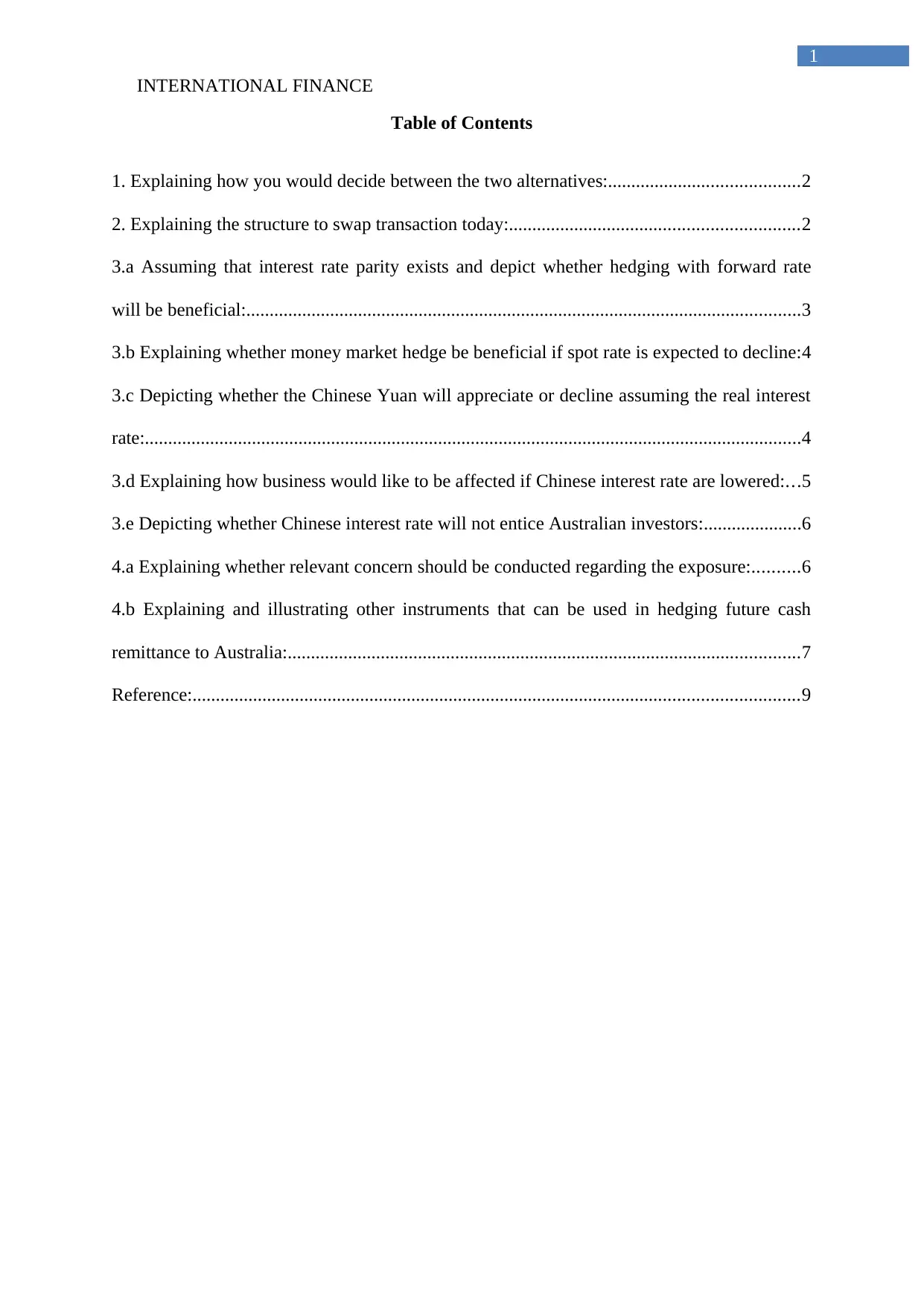
INTERNATIONAL FINANCE
1
Table of Contents
1. Explaining how you would decide between the two alternatives:.........................................2
2. Explaining the structure to swap transaction today:..............................................................2
3.a Assuming that interest rate parity exists and depict whether hedging with forward rate
will be beneficial:.......................................................................................................................3
3.b Explaining whether money market hedge be beneficial if spot rate is expected to decline:4
3.c Depicting whether the Chinese Yuan will appreciate or decline assuming the real interest
rate:.............................................................................................................................................4
3.d Explaining how business would like to be affected if Chinese interest rate are lowered:...5
3.e Depicting whether Chinese interest rate will not entice Australian investors:.....................6
4.a Explaining whether relevant concern should be conducted regarding the exposure:..........6
4.b Explaining and illustrating other instruments that can be used in hedging future cash
remittance to Australia:..............................................................................................................7
Reference:..................................................................................................................................9
1
Table of Contents
1. Explaining how you would decide between the two alternatives:.........................................2
2. Explaining the structure to swap transaction today:..............................................................2
3.a Assuming that interest rate parity exists and depict whether hedging with forward rate
will be beneficial:.......................................................................................................................3
3.b Explaining whether money market hedge be beneficial if spot rate is expected to decline:4
3.c Depicting whether the Chinese Yuan will appreciate or decline assuming the real interest
rate:.............................................................................................................................................4
3.d Explaining how business would like to be affected if Chinese interest rate are lowered:...5
3.e Depicting whether Chinese interest rate will not entice Australian investors:.....................6
4.a Explaining whether relevant concern should be conducted regarding the exposure:..........6
4.b Explaining and illustrating other instruments that can be used in hedging future cash
remittance to Australia:..............................................................................................................7
Reference:..................................................................................................................................9
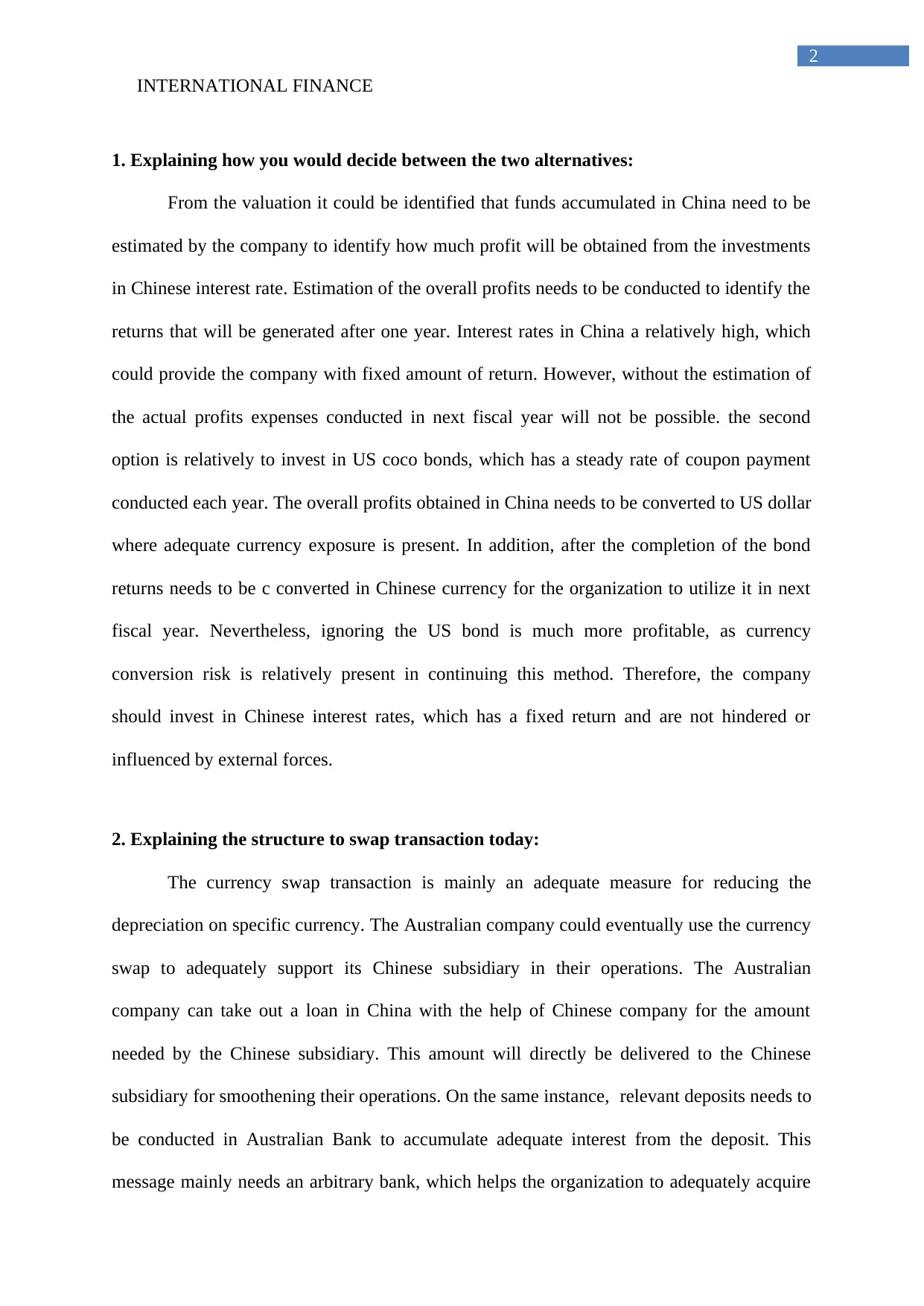
INTERNATIONAL FINANCE
2
1. Explaining how you would decide between the two alternatives:
From the valuation it could be identified that funds accumulated in China need to be
estimated by the company to identify how much profit will be obtained from the investments
in Chinese interest rate. Estimation of the overall profits needs to be conducted to identify the
returns that will be generated after one year. Interest rates in China a relatively high, which
could provide the company with fixed amount of return. However, without the estimation of
the actual profits expenses conducted in next fiscal year will not be possible. the second
option is relatively to invest in US coco bonds, which has a steady rate of coupon payment
conducted each year. The overall profits obtained in China needs to be converted to US dollar
where adequate currency exposure is present. In addition, after the completion of the bond
returns needs to be c converted in Chinese currency for the organization to utilize it in next
fiscal year. Nevertheless, ignoring the US bond is much more profitable, as currency
conversion risk is relatively present in continuing this method. Therefore, the company
should invest in Chinese interest rates, which has a fixed return and are not hindered or
influenced by external forces.
2. Explaining the structure to swap transaction today:
The currency swap transaction is mainly an adequate measure for reducing the
depreciation on specific currency. The Australian company could eventually use the currency
swap to adequately support its Chinese subsidiary in their operations. The Australian
company can take out a loan in China with the help of Chinese company for the amount
needed by the Chinese subsidiary. This amount will directly be delivered to the Chinese
subsidiary for smoothening their operations. On the same instance, relevant deposits needs to
be conducted in Australian Bank to accumulate adequate interest from the deposit. This
message mainly needs an arbitrary bank, which helps the organization to adequately acquire
2
1. Explaining how you would decide between the two alternatives:
From the valuation it could be identified that funds accumulated in China need to be
estimated by the company to identify how much profit will be obtained from the investments
in Chinese interest rate. Estimation of the overall profits needs to be conducted to identify the
returns that will be generated after one year. Interest rates in China a relatively high, which
could provide the company with fixed amount of return. However, without the estimation of
the actual profits expenses conducted in next fiscal year will not be possible. the second
option is relatively to invest in US coco bonds, which has a steady rate of coupon payment
conducted each year. The overall profits obtained in China needs to be converted to US dollar
where adequate currency exposure is present. In addition, after the completion of the bond
returns needs to be c converted in Chinese currency for the organization to utilize it in next
fiscal year. Nevertheless, ignoring the US bond is much more profitable, as currency
conversion risk is relatively present in continuing this method. Therefore, the company
should invest in Chinese interest rates, which has a fixed return and are not hindered or
influenced by external forces.
2. Explaining the structure to swap transaction today:
The currency swap transaction is mainly an adequate measure for reducing the
depreciation on specific currency. The Australian company could eventually use the currency
swap to adequately support its Chinese subsidiary in their operations. The Australian
company can take out a loan in China with the help of Chinese company for the amount
needed by the Chinese subsidiary. This amount will directly be delivered to the Chinese
subsidiary for smoothening their operations. On the same instance, relevant deposits needs to
be conducted in Australian Bank to accumulate adequate interest from the deposit. This
message mainly needs an arbitrary bank, which helps the organization to adequately acquire
⊘ This is a preview!⊘
Do you want full access?
Subscribe today to unlock all pages.

Trusted by 1+ million students worldwide
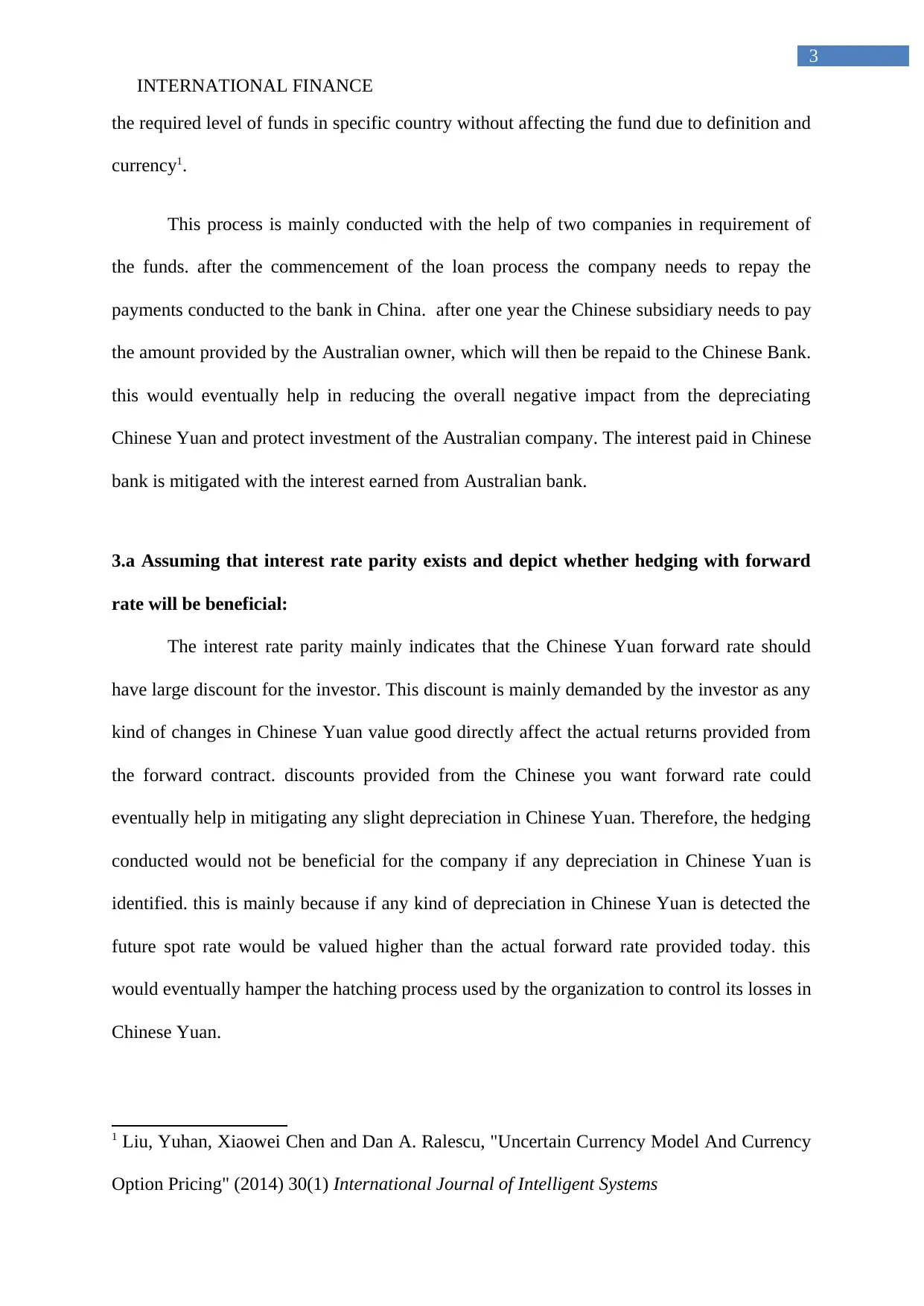
INTERNATIONAL FINANCE
3
the required level of funds in specific country without affecting the fund due to definition and
currency1.
This process is mainly conducted with the help of two companies in requirement of
the funds. after the commencement of the loan process the company needs to repay the
payments conducted to the bank in China. after one year the Chinese subsidiary needs to pay
the amount provided by the Australian owner, which will then be repaid to the Chinese Bank.
this would eventually help in reducing the overall negative impact from the depreciating
Chinese Yuan and protect investment of the Australian company. The interest paid in Chinese
bank is mitigated with the interest earned from Australian bank.
3.a Assuming that interest rate parity exists and depict whether hedging with forward
rate will be beneficial:
The interest rate parity mainly indicates that the Chinese Yuan forward rate should
have large discount for the investor. This discount is mainly demanded by the investor as any
kind of changes in Chinese Yuan value good directly affect the actual returns provided from
the forward contract. discounts provided from the Chinese you want forward rate could
eventually help in mitigating any slight depreciation in Chinese Yuan. Therefore, the hedging
conducted would not be beneficial for the company if any depreciation in Chinese Yuan is
identified. this is mainly because if any kind of depreciation in Chinese Yuan is detected the
future spot rate would be valued higher than the actual forward rate provided today. this
would eventually hamper the hatching process used by the organization to control its losses in
Chinese Yuan.
1 Liu, Yuhan, Xiaowei Chen and Dan A. Ralescu, "Uncertain Currency Model And Currency
Option Pricing" (2014) 30(1) International Journal of Intelligent Systems
3
the required level of funds in specific country without affecting the fund due to definition and
currency1.
This process is mainly conducted with the help of two companies in requirement of
the funds. after the commencement of the loan process the company needs to repay the
payments conducted to the bank in China. after one year the Chinese subsidiary needs to pay
the amount provided by the Australian owner, which will then be repaid to the Chinese Bank.
this would eventually help in reducing the overall negative impact from the depreciating
Chinese Yuan and protect investment of the Australian company. The interest paid in Chinese
bank is mitigated with the interest earned from Australian bank.
3.a Assuming that interest rate parity exists and depict whether hedging with forward
rate will be beneficial:
The interest rate parity mainly indicates that the Chinese Yuan forward rate should
have large discount for the investor. This discount is mainly demanded by the investor as any
kind of changes in Chinese Yuan value good directly affect the actual returns provided from
the forward contract. discounts provided from the Chinese you want forward rate could
eventually help in mitigating any slight depreciation in Chinese Yuan. Therefore, the hedging
conducted would not be beneficial for the company if any depreciation in Chinese Yuan is
identified. this is mainly because if any kind of depreciation in Chinese Yuan is detected the
future spot rate would be valued higher than the actual forward rate provided today. this
would eventually hamper the hatching process used by the organization to control its losses in
Chinese Yuan.
1 Liu, Yuhan, Xiaowei Chen and Dan A. Ralescu, "Uncertain Currency Model And Currency
Option Pricing" (2014) 30(1) International Journal of Intelligent Systems
Paraphrase This Document
Need a fresh take? Get an instant paraphrase of this document with our AI Paraphraser
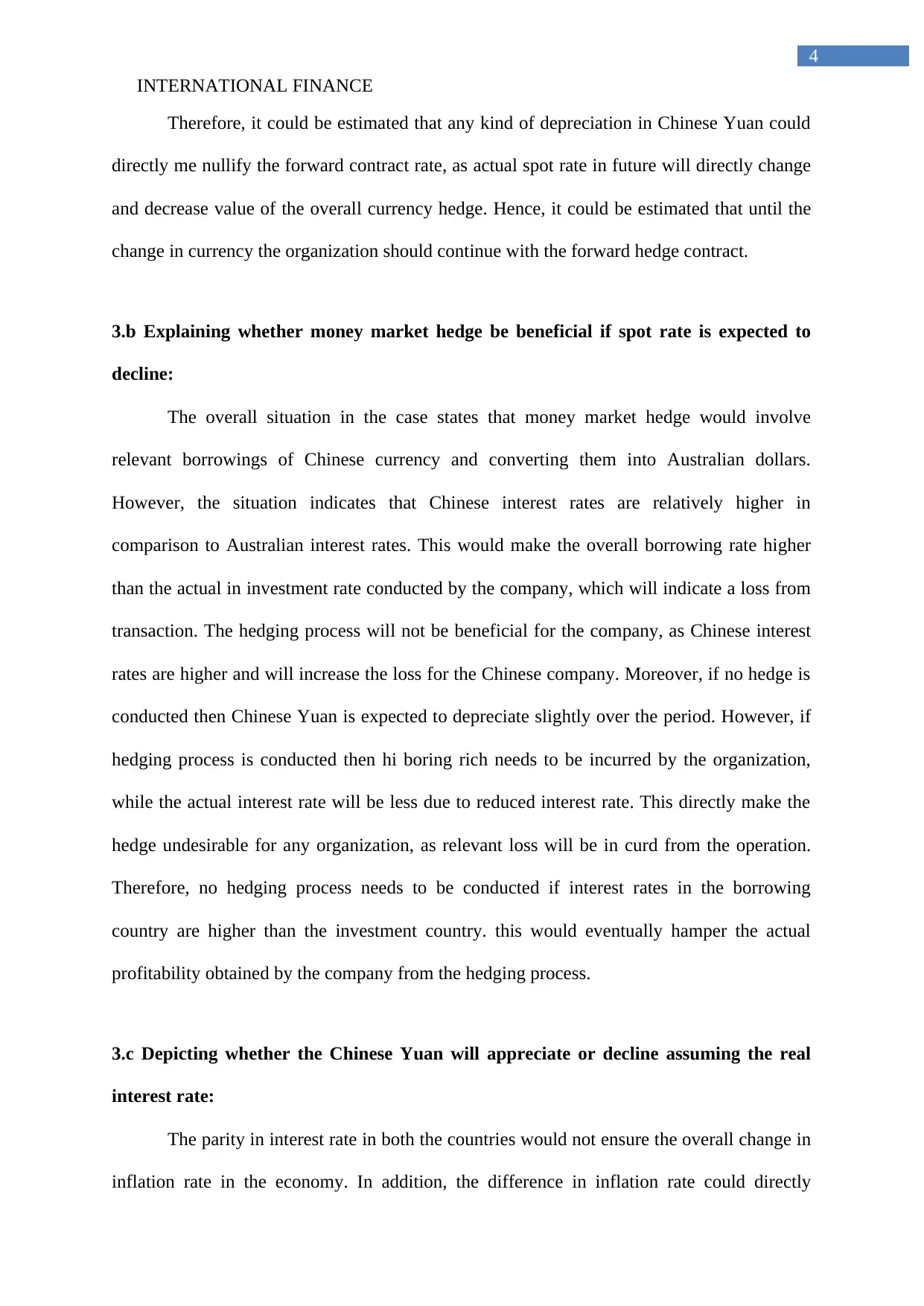
INTERNATIONAL FINANCE
4
Therefore, it could be estimated that any kind of depreciation in Chinese Yuan could
directly me nullify the forward contract rate, as actual spot rate in future will directly change
and decrease value of the overall currency hedge. Hence, it could be estimated that until the
change in currency the organization should continue with the forward hedge contract.
3.b Explaining whether money market hedge be beneficial if spot rate is expected to
decline:
The overall situation in the case states that money market hedge would involve
relevant borrowings of Chinese currency and converting them into Australian dollars.
However, the situation indicates that Chinese interest rates are relatively higher in
comparison to Australian interest rates. This would make the overall borrowing rate higher
than the actual in investment rate conducted by the company, which will indicate a loss from
transaction. The hedging process will not be beneficial for the company, as Chinese interest
rates are higher and will increase the loss for the Chinese company. Moreover, if no hedge is
conducted then Chinese Yuan is expected to depreciate slightly over the period. However, if
hedging process is conducted then hi boring rich needs to be incurred by the organization,
while the actual interest rate will be less due to reduced interest rate. This directly make the
hedge undesirable for any organization, as relevant loss will be in curd from the operation.
Therefore, no hedging process needs to be conducted if interest rates in the borrowing
country are higher than the investment country. this would eventually hamper the actual
profitability obtained by the company from the hedging process.
3.c Depicting whether the Chinese Yuan will appreciate or decline assuming the real
interest rate:
The parity in interest rate in both the countries would not ensure the overall change in
inflation rate in the economy. In addition, the difference in inflation rate could directly
4
Therefore, it could be estimated that any kind of depreciation in Chinese Yuan could
directly me nullify the forward contract rate, as actual spot rate in future will directly change
and decrease value of the overall currency hedge. Hence, it could be estimated that until the
change in currency the organization should continue with the forward hedge contract.
3.b Explaining whether money market hedge be beneficial if spot rate is expected to
decline:
The overall situation in the case states that money market hedge would involve
relevant borrowings of Chinese currency and converting them into Australian dollars.
However, the situation indicates that Chinese interest rates are relatively higher in
comparison to Australian interest rates. This would make the overall borrowing rate higher
than the actual in investment rate conducted by the company, which will indicate a loss from
transaction. The hedging process will not be beneficial for the company, as Chinese interest
rates are higher and will increase the loss for the Chinese company. Moreover, if no hedge is
conducted then Chinese Yuan is expected to depreciate slightly over the period. However, if
hedging process is conducted then hi boring rich needs to be incurred by the organization,
while the actual interest rate will be less due to reduced interest rate. This directly make the
hedge undesirable for any organization, as relevant loss will be in curd from the operation.
Therefore, no hedging process needs to be conducted if interest rates in the borrowing
country are higher than the investment country. this would eventually hamper the actual
profitability obtained by the company from the hedging process.
3.c Depicting whether the Chinese Yuan will appreciate or decline assuming the real
interest rate:
The parity in interest rate in both the countries would not ensure the overall change in
inflation rate in the economy. In addition, the difference in inflation rate could directly
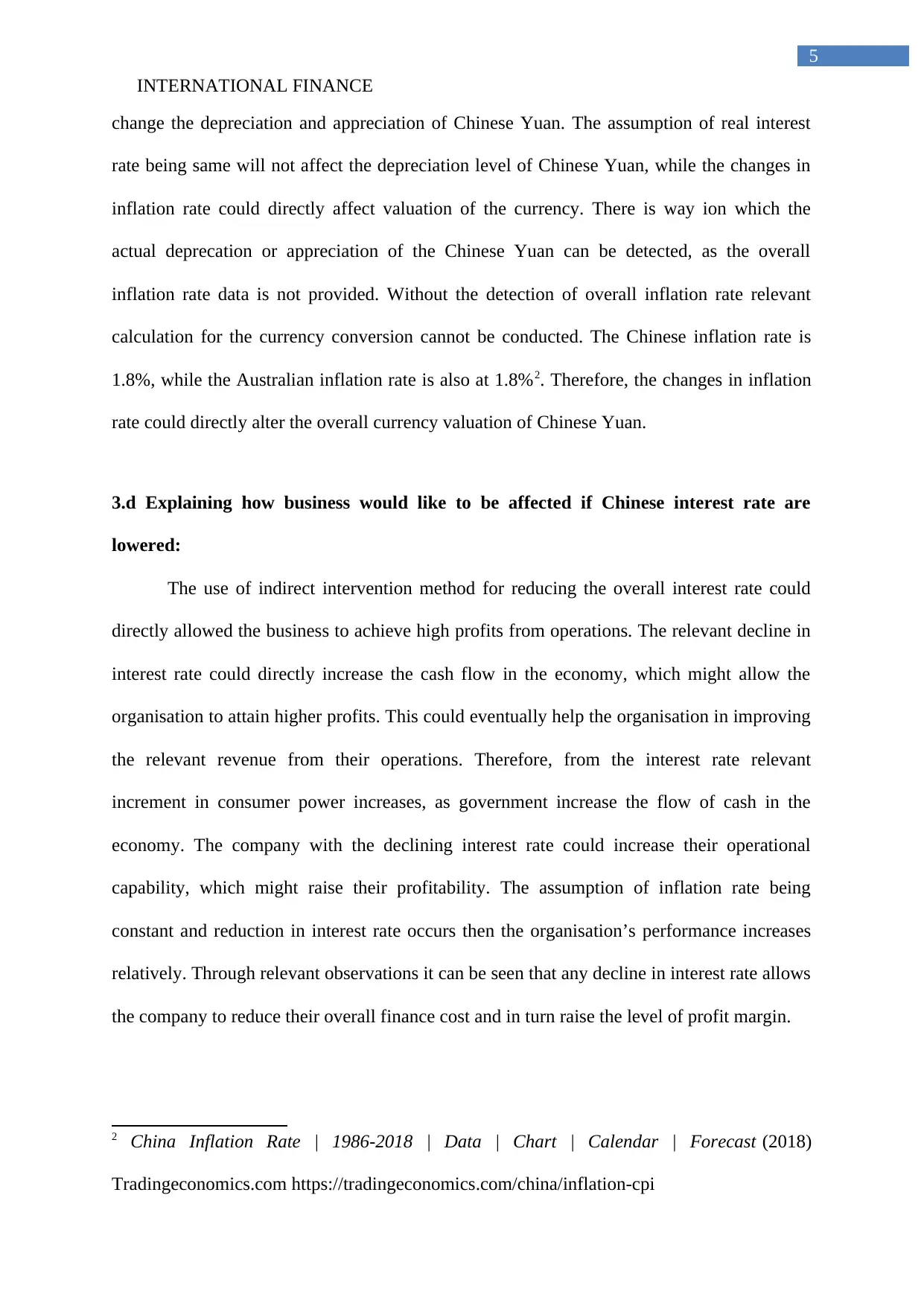
INTERNATIONAL FINANCE
5
change the depreciation and appreciation of Chinese Yuan. The assumption of real interest
rate being same will not affect the depreciation level of Chinese Yuan, while the changes in
inflation rate could directly affect valuation of the currency. There is way ion which the
actual deprecation or appreciation of the Chinese Yuan can be detected, as the overall
inflation rate data is not provided. Without the detection of overall inflation rate relevant
calculation for the currency conversion cannot be conducted. The Chinese inflation rate is
1.8%, while the Australian inflation rate is also at 1.8%2. Therefore, the changes in inflation
rate could directly alter the overall currency valuation of Chinese Yuan.
3.d Explaining how business would like to be affected if Chinese interest rate are
lowered:
The use of indirect intervention method for reducing the overall interest rate could
directly allowed the business to achieve high profits from operations. The relevant decline in
interest rate could directly increase the cash flow in the economy, which might allow the
organisation to attain higher profits. This could eventually help the organisation in improving
the relevant revenue from their operations. Therefore, from the interest rate relevant
increment in consumer power increases, as government increase the flow of cash in the
economy. The company with the declining interest rate could increase their operational
capability, which might raise their profitability. The assumption of inflation rate being
constant and reduction in interest rate occurs then the organisation’s performance increases
relatively. Through relevant observations it can be seen that any decline in interest rate allows
the company to reduce their overall finance cost and in turn raise the level of profit margin.
2 China Inflation Rate | 1986-2018 | Data | Chart | Calendar | Forecast (2018)
Tradingeconomics.com https://tradingeconomics.com/china/inflation-cpi
5
change the depreciation and appreciation of Chinese Yuan. The assumption of real interest
rate being same will not affect the depreciation level of Chinese Yuan, while the changes in
inflation rate could directly affect valuation of the currency. There is way ion which the
actual deprecation or appreciation of the Chinese Yuan can be detected, as the overall
inflation rate data is not provided. Without the detection of overall inflation rate relevant
calculation for the currency conversion cannot be conducted. The Chinese inflation rate is
1.8%, while the Australian inflation rate is also at 1.8%2. Therefore, the changes in inflation
rate could directly alter the overall currency valuation of Chinese Yuan.
3.d Explaining how business would like to be affected if Chinese interest rate are
lowered:
The use of indirect intervention method for reducing the overall interest rate could
directly allowed the business to achieve high profits from operations. The relevant decline in
interest rate could directly increase the cash flow in the economy, which might allow the
organisation to attain higher profits. This could eventually help the organisation in improving
the relevant revenue from their operations. Therefore, from the interest rate relevant
increment in consumer power increases, as government increase the flow of cash in the
economy. The company with the declining interest rate could increase their operational
capability, which might raise their profitability. The assumption of inflation rate being
constant and reduction in interest rate occurs then the organisation’s performance increases
relatively. Through relevant observations it can be seen that any decline in interest rate allows
the company to reduce their overall finance cost and in turn raise the level of profit margin.
2 China Inflation Rate | 1986-2018 | Data | Chart | Calendar | Forecast (2018)
Tradingeconomics.com https://tradingeconomics.com/china/inflation-cpi
⊘ This is a preview!⊘
Do you want full access?
Subscribe today to unlock all pages.

Trusted by 1+ million students worldwide
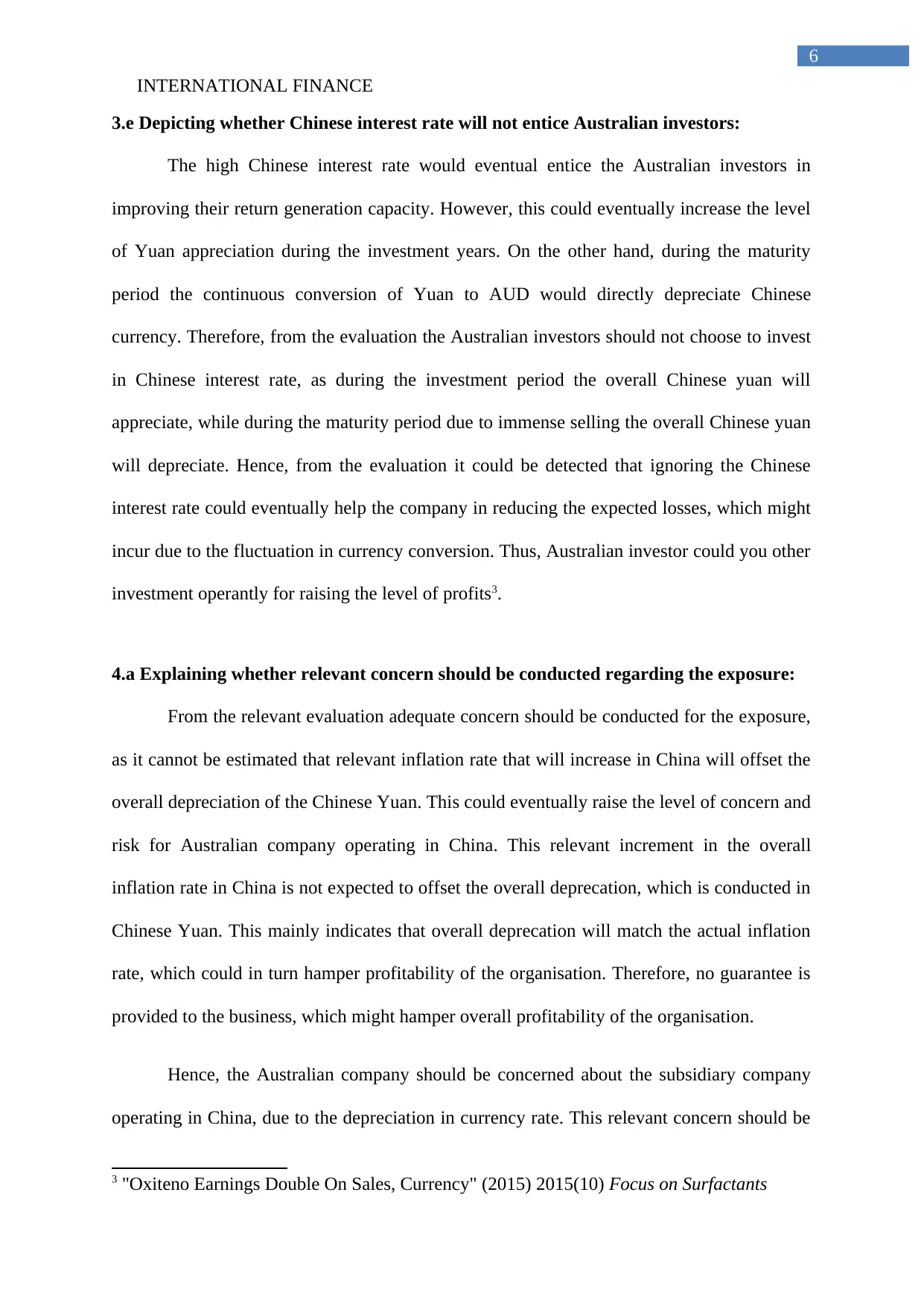
INTERNATIONAL FINANCE
6
3.e Depicting whether Chinese interest rate will not entice Australian investors:
The high Chinese interest rate would eventual entice the Australian investors in
improving their return generation capacity. However, this could eventually increase the level
of Yuan appreciation during the investment years. On the other hand, during the maturity
period the continuous conversion of Yuan to AUD would directly depreciate Chinese
currency. Therefore, from the evaluation the Australian investors should not choose to invest
in Chinese interest rate, as during the investment period the overall Chinese yuan will
appreciate, while during the maturity period due to immense selling the overall Chinese yuan
will depreciate. Hence, from the evaluation it could be detected that ignoring the Chinese
interest rate could eventually help the company in reducing the expected losses, which might
incur due to the fluctuation in currency conversion. Thus, Australian investor could you other
investment operantly for raising the level of profits3.
4.a Explaining whether relevant concern should be conducted regarding the exposure:
From the relevant evaluation adequate concern should be conducted for the exposure,
as it cannot be estimated that relevant inflation rate that will increase in China will offset the
overall depreciation of the Chinese Yuan. This could eventually raise the level of concern and
risk for Australian company operating in China. This relevant increment in the overall
inflation rate in China is not expected to offset the overall deprecation, which is conducted in
Chinese Yuan. This mainly indicates that overall deprecation will match the actual inflation
rate, which could in turn hamper profitability of the organisation. Therefore, no guarantee is
provided to the business, which might hamper overall profitability of the organisation.
Hence, the Australian company should be concerned about the subsidiary company
operating in China, due to the depreciation in currency rate. This relevant concern should be
3 "Oxiteno Earnings Double On Sales, Currency" (2015) 2015(10) Focus on Surfactants
6
3.e Depicting whether Chinese interest rate will not entice Australian investors:
The high Chinese interest rate would eventual entice the Australian investors in
improving their return generation capacity. However, this could eventually increase the level
of Yuan appreciation during the investment years. On the other hand, during the maturity
period the continuous conversion of Yuan to AUD would directly depreciate Chinese
currency. Therefore, from the evaluation the Australian investors should not choose to invest
in Chinese interest rate, as during the investment period the overall Chinese yuan will
appreciate, while during the maturity period due to immense selling the overall Chinese yuan
will depreciate. Hence, from the evaluation it could be detected that ignoring the Chinese
interest rate could eventually help the company in reducing the expected losses, which might
incur due to the fluctuation in currency conversion. Thus, Australian investor could you other
investment operantly for raising the level of profits3.
4.a Explaining whether relevant concern should be conducted regarding the exposure:
From the relevant evaluation adequate concern should be conducted for the exposure,
as it cannot be estimated that relevant inflation rate that will increase in China will offset the
overall depreciation of the Chinese Yuan. This could eventually raise the level of concern and
risk for Australian company operating in China. This relevant increment in the overall
inflation rate in China is not expected to offset the overall deprecation, which is conducted in
Chinese Yuan. This mainly indicates that overall deprecation will match the actual inflation
rate, which could in turn hamper profitability of the organisation. Therefore, no guarantee is
provided to the business, which might hamper overall profitability of the organisation.
Hence, the Australian company should be concerned about the subsidiary company
operating in China, due to the depreciation in currency rate. This relevant concern should be
3 "Oxiteno Earnings Double On Sales, Currency" (2015) 2015(10) Focus on Surfactants
Paraphrase This Document
Need a fresh take? Get an instant paraphrase of this document with our AI Paraphraser
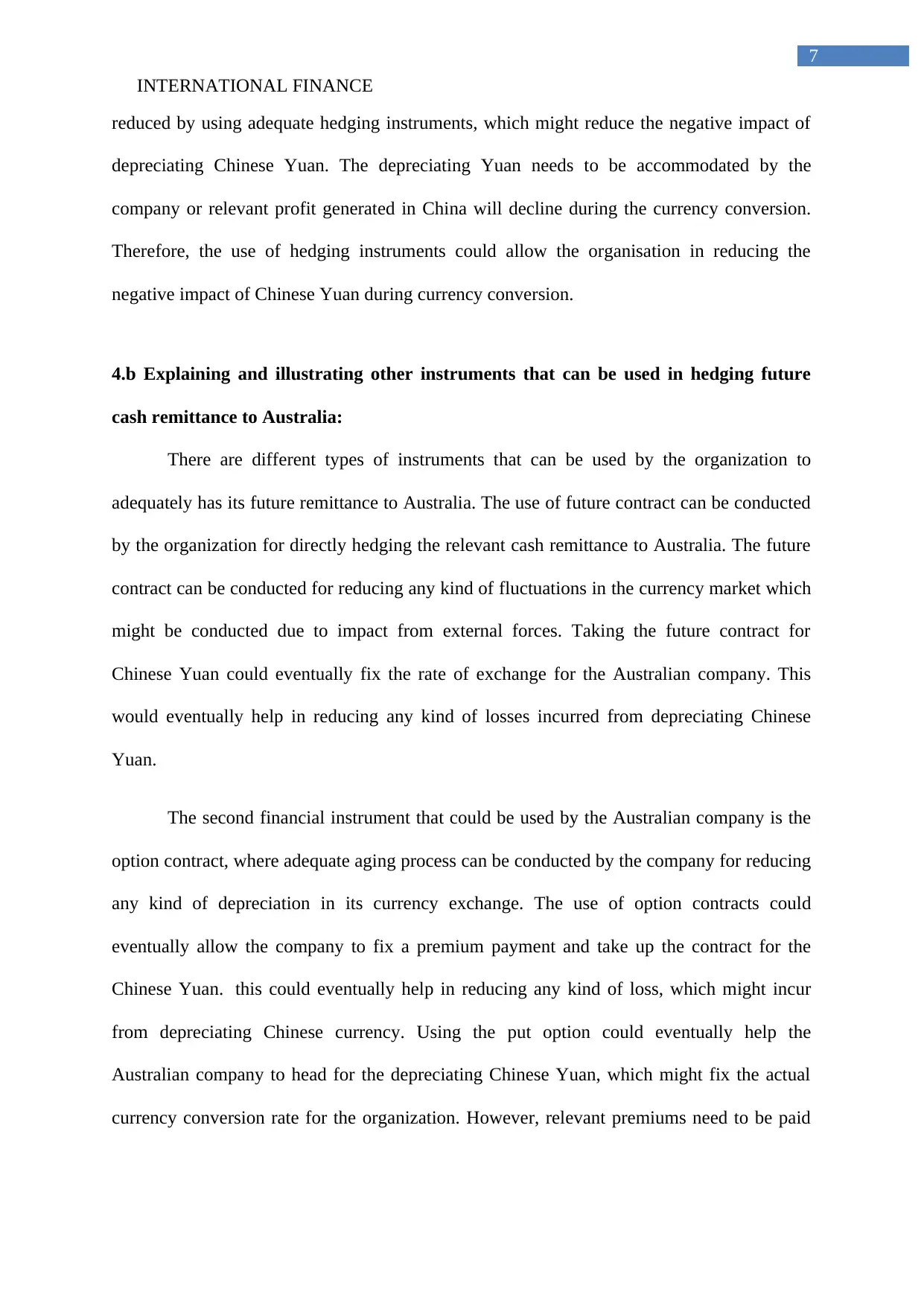
INTERNATIONAL FINANCE
7
reduced by using adequate hedging instruments, which might reduce the negative impact of
depreciating Chinese Yuan. The depreciating Yuan needs to be accommodated by the
company or relevant profit generated in China will decline during the currency conversion.
Therefore, the use of hedging instruments could allow the organisation in reducing the
negative impact of Chinese Yuan during currency conversion.
4.b Explaining and illustrating other instruments that can be used in hedging future
cash remittance to Australia:
There are different types of instruments that can be used by the organization to
adequately has its future remittance to Australia. The use of future contract can be conducted
by the organization for directly hedging the relevant cash remittance to Australia. The future
contract can be conducted for reducing any kind of fluctuations in the currency market which
might be conducted due to impact from external forces. Taking the future contract for
Chinese Yuan could eventually fix the rate of exchange for the Australian company. This
would eventually help in reducing any kind of losses incurred from depreciating Chinese
Yuan.
The second financial instrument that could be used by the Australian company is the
option contract, where adequate aging process can be conducted by the company for reducing
any kind of depreciation in its currency exchange. The use of option contracts could
eventually allow the company to fix a premium payment and take up the contract for the
Chinese Yuan. this could eventually help in reducing any kind of loss, which might incur
from depreciating Chinese currency. Using the put option could eventually help the
Australian company to head for the depreciating Chinese Yuan, which might fix the actual
currency conversion rate for the organization. However, relevant premiums need to be paid
7
reduced by using adequate hedging instruments, which might reduce the negative impact of
depreciating Chinese Yuan. The depreciating Yuan needs to be accommodated by the
company or relevant profit generated in China will decline during the currency conversion.
Therefore, the use of hedging instruments could allow the organisation in reducing the
negative impact of Chinese Yuan during currency conversion.
4.b Explaining and illustrating other instruments that can be used in hedging future
cash remittance to Australia:
There are different types of instruments that can be used by the organization to
adequately has its future remittance to Australia. The use of future contract can be conducted
by the organization for directly hedging the relevant cash remittance to Australia. The future
contract can be conducted for reducing any kind of fluctuations in the currency market which
might be conducted due to impact from external forces. Taking the future contract for
Chinese Yuan could eventually fix the rate of exchange for the Australian company. This
would eventually help in reducing any kind of losses incurred from depreciating Chinese
Yuan.
The second financial instrument that could be used by the Australian company is the
option contract, where adequate aging process can be conducted by the company for reducing
any kind of depreciation in its currency exchange. The use of option contracts could
eventually allow the company to fix a premium payment and take up the contract for the
Chinese Yuan. this could eventually help in reducing any kind of loss, which might incur
from depreciating Chinese currency. Using the put option could eventually help the
Australian company to head for the depreciating Chinese Yuan, which might fix the actual
currency conversion rate for the organization. However, relevant premiums need to be paid
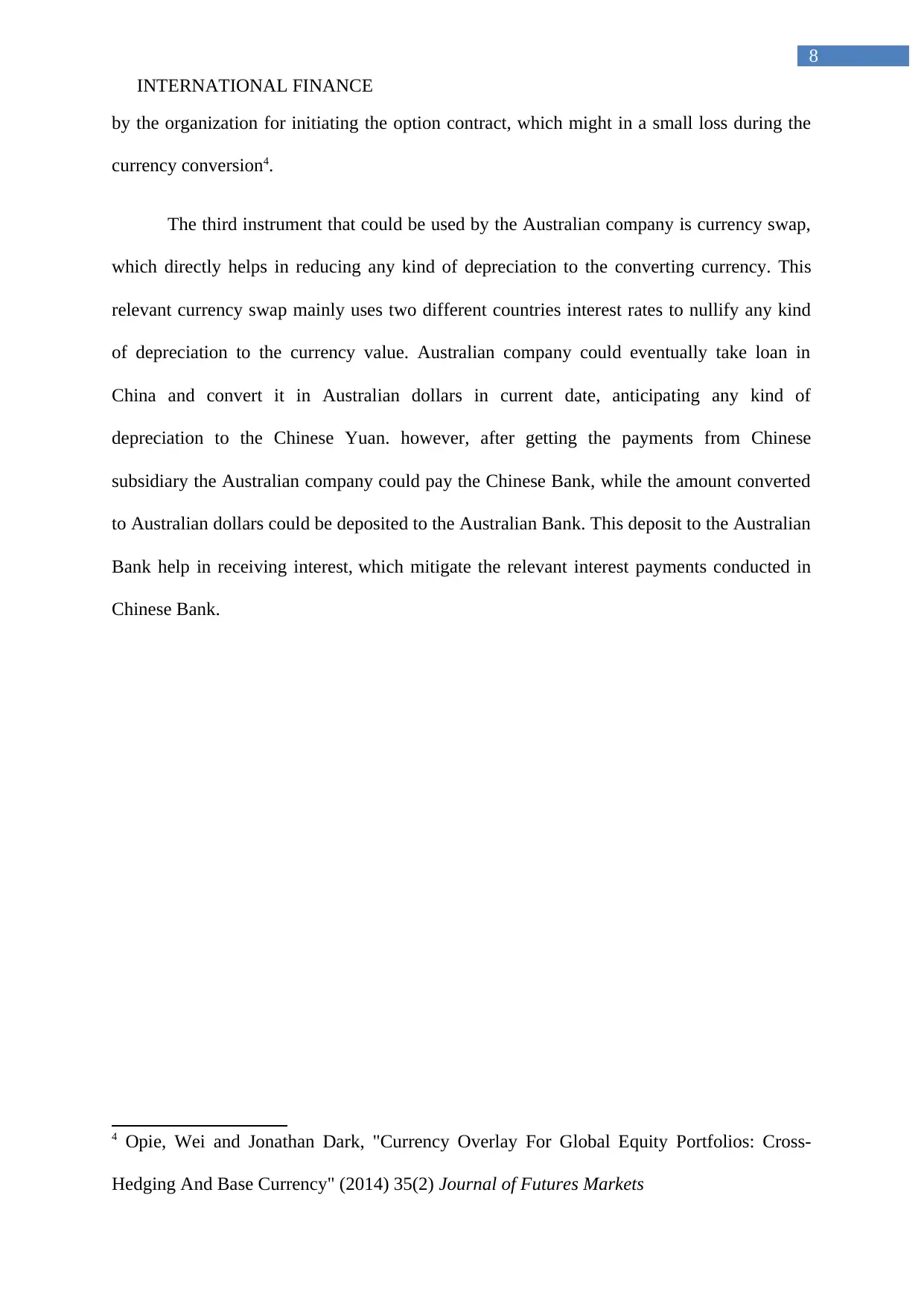
INTERNATIONAL FINANCE
8
by the organization for initiating the option contract, which might in a small loss during the
currency conversion4.
The third instrument that could be used by the Australian company is currency swap,
which directly helps in reducing any kind of depreciation to the converting currency. This
relevant currency swap mainly uses two different countries interest rates to nullify any kind
of depreciation to the currency value. Australian company could eventually take loan in
China and convert it in Australian dollars in current date, anticipating any kind of
depreciation to the Chinese Yuan. however, after getting the payments from Chinese
subsidiary the Australian company could pay the Chinese Bank, while the amount converted
to Australian dollars could be deposited to the Australian Bank. This deposit to the Australian
Bank help in receiving interest, which mitigate the relevant interest payments conducted in
Chinese Bank.
4 Opie, Wei and Jonathan Dark, "Currency Overlay For Global Equity Portfolios: Cross-
Hedging And Base Currency" (2014) 35(2) Journal of Futures Markets
8
by the organization for initiating the option contract, which might in a small loss during the
currency conversion4.
The third instrument that could be used by the Australian company is currency swap,
which directly helps in reducing any kind of depreciation to the converting currency. This
relevant currency swap mainly uses two different countries interest rates to nullify any kind
of depreciation to the currency value. Australian company could eventually take loan in
China and convert it in Australian dollars in current date, anticipating any kind of
depreciation to the Chinese Yuan. however, after getting the payments from Chinese
subsidiary the Australian company could pay the Chinese Bank, while the amount converted
to Australian dollars could be deposited to the Australian Bank. This deposit to the Australian
Bank help in receiving interest, which mitigate the relevant interest payments conducted in
Chinese Bank.
4 Opie, Wei and Jonathan Dark, "Currency Overlay For Global Equity Portfolios: Cross-
Hedging And Base Currency" (2014) 35(2) Journal of Futures Markets
⊘ This is a preview!⊘
Do you want full access?
Subscribe today to unlock all pages.

Trusted by 1+ million students worldwide
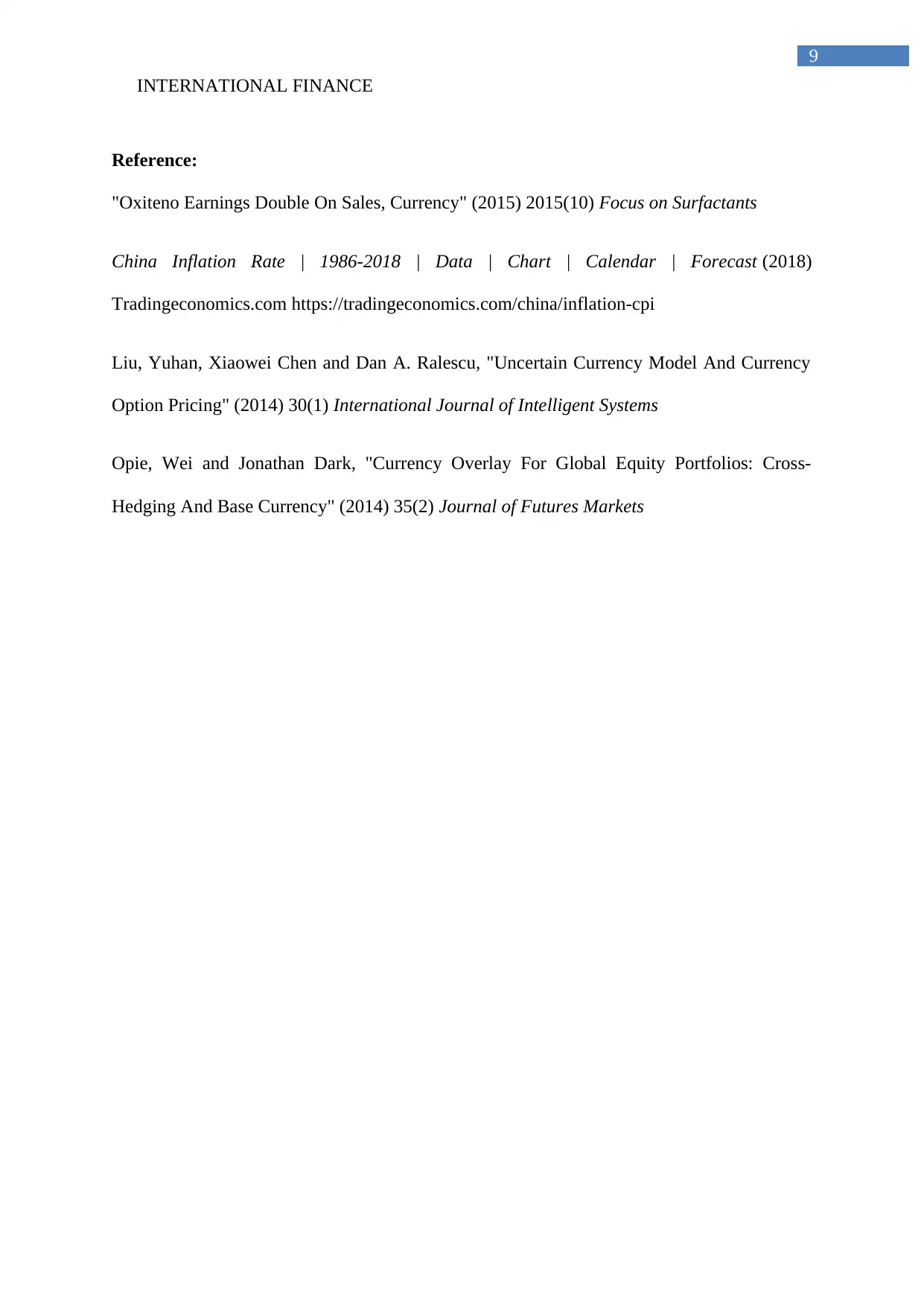
INTERNATIONAL FINANCE
9
Reference:
"Oxiteno Earnings Double On Sales, Currency" (2015) 2015(10) Focus on Surfactants
China Inflation Rate | 1986-2018 | Data | Chart | Calendar | Forecast (2018)
Tradingeconomics.com https://tradingeconomics.com/china/inflation-cpi
Liu, Yuhan, Xiaowei Chen and Dan A. Ralescu, "Uncertain Currency Model And Currency
Option Pricing" (2014) 30(1) International Journal of Intelligent Systems
Opie, Wei and Jonathan Dark, "Currency Overlay For Global Equity Portfolios: Cross-
Hedging And Base Currency" (2014) 35(2) Journal of Futures Markets
9
Reference:
"Oxiteno Earnings Double On Sales, Currency" (2015) 2015(10) Focus on Surfactants
China Inflation Rate | 1986-2018 | Data | Chart | Calendar | Forecast (2018)
Tradingeconomics.com https://tradingeconomics.com/china/inflation-cpi
Liu, Yuhan, Xiaowei Chen and Dan A. Ralescu, "Uncertain Currency Model And Currency
Option Pricing" (2014) 30(1) International Journal of Intelligent Systems
Opie, Wei and Jonathan Dark, "Currency Overlay For Global Equity Portfolios: Cross-
Hedging And Base Currency" (2014) 35(2) Journal of Futures Markets
1 out of 10
Related Documents
Your All-in-One AI-Powered Toolkit for Academic Success.
+13062052269
info@desklib.com
Available 24*7 on WhatsApp / Email
![[object Object]](/_next/static/media/star-bottom.7253800d.svg)
Unlock your academic potential
Copyright © 2020–2025 A2Z Services. All Rights Reserved. Developed and managed by ZUCOL.




